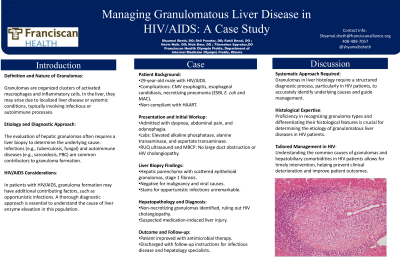Monday Poster Session
Category: Liver
P3056 - Managing Granulomatous Liver Disease in HIV/AIDS: A Case Study
Monday, October 28, 2024
10:30 AM - 4:00 PM ET
Location: Exhibit Hall E

Has Audio

Shyamal Sheth, DO
Franciscan Health Olympia Fields
Chicago, IL
Presenting Author(s)
Shyamal Sheth, DO1, Shil Punatar, DO1, Rahil Desai, DO1, Navin Naik, DO2, Nick Baur, DO2, Tilemahos Spyratos, DO1
1Franciscan Health Olympia Fields, Chicago, IL; 2Franciscan Health Olympia Fields, Olympia Fields, IL
Introduction: Granulomas are recognized discrete collections of activated macrophages and other inflammatory cells. While these may manifest in hepatic tissue as a component of localized liver disease or as part of a systemic process they typically are infectious or autoimmune in nature. The detection and evaluation of granulomatous liver diseases often necessitate a liver biopsy. Within the setting of patient’s with HIV/AIDS, a similar approach is followed with considerations of other contributions to granuloma formation and liver disease. Here we present the approach to liver enzyme elevation and granuloma consideration in the HIV/AIDS patient.
Case Description/Methods: Our patient is a 29-year-old male with HIV/AIDS complicated by CMV esophagitis, esophageal candidiasis, and necrotizing pneumonia secondary to ESBL- Escheria Coli and MAC. Patient is largely non-compliant with HAART, and was admitted for dyspnea, abdominal pain, and odynophagia. Laboratory tests revealed elevated alkaline phosphatase, alanine transaminase, and aspartate transaminase levels. Considerations of large duct obstruction and HIV cholangiopathy were excluded given findings from initial right upper quadrant ultrasound and MRCP; therefore, liver biopsy was pursued. The initial biopsy revealed hepatic parenchyma with scattered prominent epithelioid granulomas and stage 1 fibrosis, negative for malignancy and viral causes. Given HIV status, further stains for opportunistic infections were also unremarkable. Subsequent evaluation by a hepatopathologist identified non-necrotizing granulomas, which also ruled out HIV cholangiopathy leading to further consideration of injury from the patient’s medication regimen. The patient improved and was discharged with appropriate antimicrobial therapy with instructions to follow-up with an infectious disease specialist and hepatology.
Discussion: Granulomas, while frequently encountered in histological liver specimens, necessitate a systematic approach for accurate diagnosis and management, with special considerations in the HIV patient. Proficiency in identifying histological features, differentiating granuloma types, and understanding common etiologies of granulomatous liver diseases and hepatobiliary comorbidities is the HIV patient essential for precise diagnosis, intervention, and prevention of subsequent clinical decline.
Disclosures:
Shyamal Sheth, DO1, Shil Punatar, DO1, Rahil Desai, DO1, Navin Naik, DO2, Nick Baur, DO2, Tilemahos Spyratos, DO1. P3056 - Managing Granulomatous Liver Disease in HIV/AIDS: A Case Study, ACG 2024 Annual Scientific Meeting Abstracts. Philadelphia, PA: American College of Gastroenterology.
1Franciscan Health Olympia Fields, Chicago, IL; 2Franciscan Health Olympia Fields, Olympia Fields, IL
Introduction: Granulomas are recognized discrete collections of activated macrophages and other inflammatory cells. While these may manifest in hepatic tissue as a component of localized liver disease or as part of a systemic process they typically are infectious or autoimmune in nature. The detection and evaluation of granulomatous liver diseases often necessitate a liver biopsy. Within the setting of patient’s with HIV/AIDS, a similar approach is followed with considerations of other contributions to granuloma formation and liver disease. Here we present the approach to liver enzyme elevation and granuloma consideration in the HIV/AIDS patient.
Case Description/Methods: Our patient is a 29-year-old male with HIV/AIDS complicated by CMV esophagitis, esophageal candidiasis, and necrotizing pneumonia secondary to ESBL- Escheria Coli and MAC. Patient is largely non-compliant with HAART, and was admitted for dyspnea, abdominal pain, and odynophagia. Laboratory tests revealed elevated alkaline phosphatase, alanine transaminase, and aspartate transaminase levels. Considerations of large duct obstruction and HIV cholangiopathy were excluded given findings from initial right upper quadrant ultrasound and MRCP; therefore, liver biopsy was pursued. The initial biopsy revealed hepatic parenchyma with scattered prominent epithelioid granulomas and stage 1 fibrosis, negative for malignancy and viral causes. Given HIV status, further stains for opportunistic infections were also unremarkable. Subsequent evaluation by a hepatopathologist identified non-necrotizing granulomas, which also ruled out HIV cholangiopathy leading to further consideration of injury from the patient’s medication regimen. The patient improved and was discharged with appropriate antimicrobial therapy with instructions to follow-up with an infectious disease specialist and hepatology.
Discussion: Granulomas, while frequently encountered in histological liver specimens, necessitate a systematic approach for accurate diagnosis and management, with special considerations in the HIV patient. Proficiency in identifying histological features, differentiating granuloma types, and understanding common etiologies of granulomatous liver diseases and hepatobiliary comorbidities is the HIV patient essential for precise diagnosis, intervention, and prevention of subsequent clinical decline.
Disclosures:
Shyamal Sheth indicated no relevant financial relationships.
Shil Punatar indicated no relevant financial relationships.
Rahil Desai indicated no relevant financial relationships.
Navin Naik indicated no relevant financial relationships.
Nick Baur indicated no relevant financial relationships.
Tilemahos Spyratos indicated no relevant financial relationships.
Shyamal Sheth, DO1, Shil Punatar, DO1, Rahil Desai, DO1, Navin Naik, DO2, Nick Baur, DO2, Tilemahos Spyratos, DO1. P3056 - Managing Granulomatous Liver Disease in HIV/AIDS: A Case Study, ACG 2024 Annual Scientific Meeting Abstracts. Philadelphia, PA: American College of Gastroenterology.
